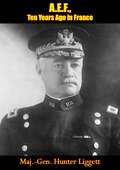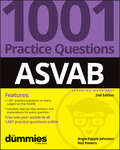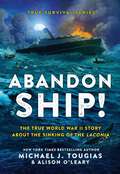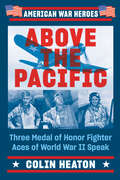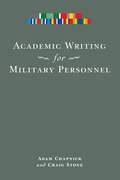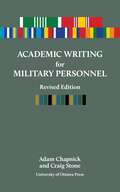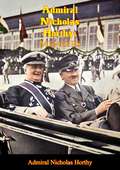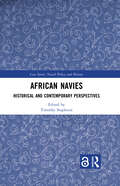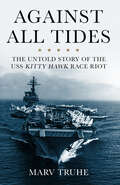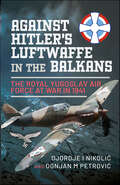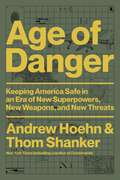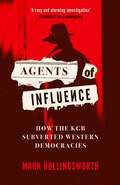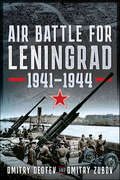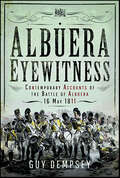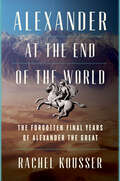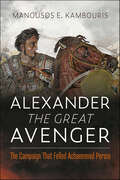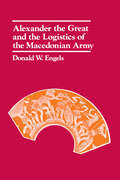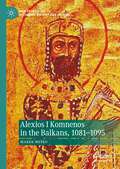- Table View
- List View
A Wife's Courage: The BRAND NEW Battersea saga for 2023 from the Sunday Times bestselling author
by Kitty NealeLondon, 1944. With bombs raining over London, keeping the Battersea Tavern open is no easy feat for owner Winnie Berry - but the community need the warmth and familiarity of the pub more than ever.After marriage, Maureen Fanning had moved out to Wandsworth with her bad-tempered husband Brancher. But when he loses both his job and their lodgings, the only people who will take them in are her kindly grandparents, Len and Renee. Getting a cleaning job at the Battersea Tavern is the least she can do to pay them back. It would all be fine... if it weren't for Brancher.Winnie is determined to take timid Maureen under her wing. But when tragedy strikes, it will be up to Maureen to find the strength she didn't know she possessed...
A.E.F., Ten Years Ago in France
by Maj.-Gen. Hunter LiggettA fascinating series of accounts from Major-General Hunter Liggett who commanded 41st Division, then 1st Army Corps, A.E.F. before the entire 1st American Army. A significant and underappreciated leader of the United States war effort during the First World War and a prominent member of the U.S. army command for over four decades.“Lieutenant General Hunter Liggett (March 21, 1857 − December 30, 1935) was a senior United States Army officer. His 42 years of military service spanned the period from the Indian campaigns to the trench warfare of World War I. Additionally, he also identified possible invasion sites in Luzon, particularly Lingayen Gulf, which were used during World War II in 1941 by the Japanese and in 1945 by the United States.Success in brigade commands in Texas and in the Philippines led to his promotion to major general, and selection as commander of the 41st Division in April 1917. The division served in France as part of the American Expeditionary Force. When his division was disestablished, he took command of I Corps.Under Liggett's leadership, the I Corps participated in the Second Battle of the Marne and in the reduction of the Saint-Mihiel salient. In October 1918, as commander of the First United States Army with the rank of lieutenant general in the national army, he directed the final phases of the Meuse-Argonne offensive and the pursuit of German forces until the armistice. After commanding the post-war Army of Occupation, Liggett returned to his permanent rank of major general, and retired in 1921.Throughout most of this period, Liggett's aide-de-camp was James Garesche Ord, a major general in World War II.”-Wiki
ASVAB Prep Plus 2024-2025: 6 Practice Tests + Proven Strategies + Online + Video (Kaplan Test Prep)
by Kaplan Test PrepKaplan&’s ASVAB Prep Plus 2024–2025 features proven strategies and realistic practice for all sections of the ASVAB and AFQT. Comprehensive subject review, expert tips, detailed explanations, and flashcards will help you face the test with confidence.Kaplan is so certain that ASVAB Prep Plus offers all the knowledge you need to excel at the ASVAB that we guarantee it: After studying with the online resources and book, you&’ll score higher on the test—or you&’ll get your money back.Essential PracticeMore than 1,000 realistic practice questions with explanationsSix full-length ASVAB practice tests with detailed explanations: 3 online and 3 in the bookFlashcards in the book and also in an app to review on the goQbank for more online practice with every question typeDetailed subject review, including targeted strategies for vocabulary questions and math problem solvingAn extensive word list to help you build your vocabularyMath video instruction to provide refreshers on the tested concepts Expert GuidanceComprehensive content review and specific methods for tackling all technical topics: science, electronics, auto/shop, mechanical information, and object assemblySpecific strategies for mastering the Computer Adaptive Test formatWe invented test prep—Kaplan (kaptest.com) has been helping students for 80 years. Our proven strategies have helped legions of students achieve their dreams.
ASVAB Total Prep 2024-2025: 7 Practice Tests + Proven Strategies + Video + Flashcards (Kaplan Test Prep)
by Kaplan Test PrepKaplan&’s ASVAB Total Prep 2024–2025 features proven strategies and realistic practice for all sections of the ASVAB and AFQT. Comprehensive subject review, expert tips, detailed explanations, and flashcards will help you face the test with confidence.Kaplan is so certain that ASVAB Total Prep offers all the knowledge you need to excel at the ASVAB that we guarantee it: After studying with the online resources and book, you&’ll score higher on the test—or you&’ll get your money back.Essential PracticeMore than 2,600 realistic practice questions with explanationsSeven full-length ASVAB practice tests with detailed explanations: 4 online and 3 in the bookFlashcards in the book and also in an app to review on the goQbank for more online practice with every question typeDetailed subject review, including targeted strategies for vocabulary questions and math problem solvingAn extensive word list to help you build your vocabularyMath video instruction to provide refreshers on the tested concepts Expert GuidanceComprehensive content review and specific methods for tackling all technical topics: science, electronics, auto/shop, mechanical information, and object assemblySpecific strategies for mastering the Computer Adaptive Test formatWe invented test prep—Kaplan (kaptest.com) has been helping students for 80 years. Our proven strategies have helped legions of students achieve their dreams.
ASVAB: 1001 Practice Questions For Dummies (+ Online Practice)
by Rod Powers Angie Papple JohnstonPractice your way to the best score you can get on the ASVAB ASVAB: 1001 Practice Questions For Dummies gives you 1,001 opportunities to practice answering questions on key concepts for all nine ASVAB subtests—in the book and online! Get the score you need to qualify for the military job you want, or raise your score to get a new job or advance in rank, with this useful book. These practice questions and detailed answer explanations will put you on the path to the greatest possible job flexibility, no matter what your skill level. Thanks to this Dummies practice guide, you have a resource to help you achieve your military career goals. Work through practice questions on all topics covered on the ASVAB exam Read through detailed explanations of the answers to build your understanding Access practice questions online to bolster your readiness anywhere, any time Improve your score and up your ASVAB study game with practice, practice, practiceThe material presented in ASVAB: 1001 Practice Questions For Dummies is an excellent resource for anyone planning to take the ASVAB and enlist in the U.S. armed services this year.
Abandon Ship!: The True World War II Story About the Sinking of the Laconia (True Survival Series #1)
by Michael J. Tougias Alison O'LearyA remarkable World War II account of a maritime attack off the West African coast, for fans of Steven Sheinkin and Deborah Heiligman. At the height of World War II, the RMS Laconia was torpedoed by a German submarine five hundred miles off the coast of western Africa. The attack triggered a series of unprecedented events involving allies and enemies from both sides, and left survivors adrift at sea in shark infested oceans, fighting to stay alive with little food or water. Suspenseful and informative, and featuring historic photographs, this incredible true account is a testament to the idea that compassion can rule over conflict—even during the cruelties of war. A Junior Library Guild Gold Standard Selection "This epic story races along, unspooling like a movie before our eyes—artfully, dramatically, revealing a little known part of WWII history. An intriguing book."―Doug Stanton, #1 New York Times bestselling author of In Harm&’s Way "The authors do an excellent job of conveying the chaos and loss of this grisly historical incident without pushing young readers too deeply into the horror. Many of those who lived through the Laconia catastrophe endured weeks at sea, parched and sunburned and starving in conditions that literally drove men mad. Archival photos add immediacy to this sensational true-life story." ―Wall Street Journal "An amazing account of a World War II event that is almost entirely unknown…. This story chronicles the courage, compassion, and perseverance of the few survivors of the incident, showcasing war at its worst and humanity at its best…. School librarians will want to add this to their collection." ―Booklist
Above the Pacific: Three Medal of Honor Fighter Aces of World War II Speak (American War Heroes)
by Colin HeatonThree legendary fighter pilots from the Pacific War—all recipients of the Medal of Honor—tell their own stories in this remarkable collection. Marine ace Pappy Boyington is perhaps the most celebrated of all American pilots in the war against Japan, fighting in the skies with both the famed Flying Tigers and his own Black Sheep Squadron. Marine Joe Foss joined Guadalcanal&’s Cactus Air Force and destroyed a Japanese Zero on his first mission—the first of twenty-six aerial kills achieved during the war. Navy captain David McCampbell didn&’t notch his first kill until June 1944, but he would quickly go on to assemble one of the most remarkable aerial-combat records in history with thirty-four victories, including nine in one day. In this gripping oral history—which spans the entire war— from the Americans who fought the Japanese in China to the final, desperate battle for Okinawa, these three heroes tell their own stories, in their own words. These interviews, personally conducted by military veteran and historian Colin Heaton, are the final testimony of some of America&’s greatest warriors.
Academic Writing for Military Personnel
by Adam Chapnick Craig StoneAcademic Writing for Military Personnel is written for members of the military who are either new to or re-entering the academic community and who need to familiarize themselves with academic writing. The authors, an experienced writing instructor and a retired military officer, show how persuasive academic writing enhances officers’ effectiveness in their regular duties, especially as they reach more senior levels of service. They explain the differences between staff writing and academic writing, and outline some of the common errors military personnel make when transitioning from one to the other. The book’s chapters outline the value of strong written communication skills, the research process, the writing process, academic referencing, and frequent grammatical and syntactical errors. Specific examples chosen with a military audience in mind are integrated throughout the book to provide the reader with relevant and practical guidance. The book concludes with a discussion on how officers can use the knowledge they have acquired through their professional experiences in their academic work. As the only comprehensive guide to effective academic writing designed specifically for military personnel, this book will be a crucial addition to the libraries of junior and senior officers in militaries worldwide.
Academic Writing for Military Personnel, revised edition: Revised Edition (Standalone titles)
by Adam Chapnick Craig StoneAcademic Writing: A Guide for Military Personnel est un manuel de rédaction conçu pour aider le personnel militaire à rédiger des travaux savants dans un style clair et efficace. Fruit de la collaboration entre un professeur d’écriture chevronné et un officier militaire à la retraite, le manuel s’adresse aux membres des forces armées qui rejoignent le monde universitaire et qui ont déjà rédigé dans un contexte professionnel militaire ou qui n’ont aucune expérience de la rédaction. En plus d’enseigner aux officiers comment rédiger efficacement, cet ouvrage explique en quoi la maîtrise des techniques de rédaction est utile au personnel des forces armées dans leurs tâches régulières, en particulier aux échelons supérieurs. L’ouvrage traite de l’importance de savoir communiquer par écrit, de ce qui distingue la rédaction savante de la rédaction professionnelle, des processus de recherche et de rédaction proprement dite, du professionnalisme dans la sphère universitaire ainsi que des problèmes et défis fréquemment rencontrés par les rédactrices et les rédacteurs. Un dernier chapitre novateur traite de la manière dont les officiers peuvent mettre à profit les connaissances qu’ils ont acquises par leurs expériences professionnelles dans le contexte universitaire. Des exemples concrets — à l’usage particulier des militaires — sont présentés tout au long du texte pour guider la lectrice et le lecteur de manière pratique et pertinente.Cette édition révisée comprend de nouveaux exemples provenant d’une plus grande variété d’auteurs. Elle prend en compte l’évolution récente des technologies de communication et reflète les nouvelles avancées dans les domaines de l’enseignement et de l’apprentissage.Cet ouvrage, qui est le seul guide exhaustif sur la rédaction à l’usage du personnel militaire, est un ajout incontournable à la bibliothèque de tout officier militaire où qu’il se trouve et quel que soit son rang.Ce livre est publié en anglais. Note : Une version française de ce livre sera disponible en 2023.Formats disponibles : couverture souple, PDF accessible et ePub accessible
Admiral Nicholas Horthy: Memoirs
by Admiral Nicholas HorthyAdmiral Nicholas Horthy was the Ruler of the Kingdom of Hungary during the interwar years and throughout most of World War II, serving from 1 Mar 1920 to 15 Oct. 1944...Horthy is remembered for, among other things, trying to surrender to the Russians when he realized that the war was lost. Hitler found out that Horthy through his son was negotiating a surrender to the Russians and had Horthy and his son arrested. On 15 Oct 1944, Horthy told his government ministers that Hungary had signed an armistice with the Soviet Union. "It is clear today that Germany has lost the war... Hungary has accordingly concluded a preliminary armistice with Russia, and will cease all hostilities against her." On that same day, 15 Oct. 1944, after Horthy had announced the armistice in a nationwide radio address, but which most of his troops did not hear, Hitler sent commando Otto Skorzeny to Budapest with instructions to remove Horthy from power. Horthy's son was meeting with Soviet representatives to finalize the surrender when Skorzeny and his troops forced their way into the meeting and kidnapped the younger Horthy at gunpoint. However, he did not kill them. Both Horthys got out after the war was over and the father lived long enough to write these memoirs. -Print ed.
African Navies: Historical and Contemporary Perspectives (Cass Series: Naval Policy and History)
by Timothy StapletonThis edited volume focuses on aspects of the understudied theme of African sea-power, including African navies and the engagement of non-African navies with the continent. Africa possesses 48,000 kilometers of coastline, comprising 38 out of 54 of the continent’s states and several strategic choke points for international shipping, such as the Suez Canal, the Gulf of Aden and the Cape of Good Hope. Nevertheless, post-colonial Africa’s small navies and their relations with the navies of external powers have not received much scholarly attention. Focusing on Sub-Saharan Africa, this collection attempts to address this neglect and stimulate further research by offering original chapters related to historical and contemporary themes around Africa’s navies. The historical chapters cover the origin of the Tanzanian, Ethiopian, Nigerian and Ghana navies during the era of decolonization and the Cold War, the asymmetrical naval campaign fought during the Nigerian Civil War (1967-70), and the activities of the Soviet Navy in supporting African states and movements fighting lingering colonialism and white supremacy during the 1970s and 1980s. Focusing on the contemporary situation, other chapters discuss the engagement of the Indian Navy with Africa, the potential role of the Angolan and Mozambican navies in the Southern African Development Community (SADC), the transformation and development of the post-apartheid South African Navy, and the challenges and capabilities of African navies in the early twenty-first century. The book concludes by discussing the question of whether African coastal countries need navies. This book will be of much interest to students of naval power, strategic studies, African politics and International Relations.
After Anne: A Novel of Lucy Maud Montgomery's Life
by Logan SteinerA stunning and unexpected portrait of Lucy Maud Montgomery, creator of one of literature’s most prized heroines, whose personal demons were at odds with her most enduring legacy—the irrepressible Anne of Green Gables.“Dear old world,” she murmured, “you are very lovely, and I am glad to be alive in you.” —L. M. Montgomery, Anne of Green Gables, 1908As a young woman, Maud had dreams bigger than the whole of Prince Edward Island. Her exuberant spirit had always drawn frowns from her grandmother and their neighbors, but she knew she was meant to create, to capture and share the way she saw the world. And the young girl in Maud’s mind became more and more persistent: Here is my story, she said. Here is how my name should be spelled—Anne with an “e.”But the day Maud writes the first lines of Anne of Green Gables, she gets a visit from the handsome new minister in town, and soon faces a decision: forge her own path as a spinster authoress, or live as a rural minister’s wife, an existence she once called "a synonym for respectable slavery." The choice she makes alters the course of her life.With a husband whose religious mania threatens their health and happiness at every turn, the secret darkness that Maud herself holds inside threatens to break through the persona she shows to the world, driving an ever-widening wedge between her public face and private self, and putting her on a path towards a heartbreaking end.Beautiful and moving, After Anne reveals Maud’s hidden personal challenges while celebrating what was timeless about her life and art—the importance of tenacity and the peaceful refuge found in imagination.
After Liberation: Toward a Sociology of the Shoah<br/>Selected Essays
by H. G. Adler Jeremy AdlerH.G. Adler (1910–1988) was one of the founding figures of Holocaust scholarship whose monumental monograph Theresienstadt 1941-1945. The Face of a Coerced Community (1955; 1960) was the first study to present a fully documented account of the Final Solution. This collection gathers together, for the first time in English, some of Adler’s most important scholarly essays on the Shoah and connected themes. Ideas raised for the first time in his book on Theresienstadt are here taken up and developed at greater length, new accents are set, and new themes are explored. Spanning his thought across three decades they focus on the fate of the ‘coerced’ human being and reflect on freedom, enslavement, terror, concentration camps, persecution, the mass society, dread, loneliness, and ideology.
Against All Tides: The Untold Story of the USS Kitty Hawk Race Riot
by Marv TruheSimmering racial tensions inflamed by discriminatory punitive measures sparked a violent confrontation aboard the USS Kitty Hawk while it was engaged in air strikes off the coast of North Vietnam. The US Navy charged Black sailors with rioting and assaults on White sailors in an incident referred to as a race riot, while totally ignoring violent unprovoked assaults committed by White sailors and Marines. Author Marv Truhe was a Navy JAG defense lawyer seeking justice for the accused Black sailors. Truhe possesses one of the most complete collections, personal or institutional, of original source documents of the Kitty Hawk incident and its legal aftermath—trial transcripts, investigation reports, hundreds of sworn statements and medical reports, federal court pleadings, and case files and witness interviews. How could virtually all official and unofficial accounts of the incident have placed blame for the incident solely on twenty-three Black sailors? How could they have been subjected to blatant racial injustices without their story being told until now? It is time to reveal the uncomfortable answers to these questions and expose the injustices perpetrated against these twenty-three young men.
Against Hitler's Luftwaffe in the Balkans: The Royal Yugoslav Air Force at War in 1941
by Djordje I. Nikolic Ognjan M. Petrovic“The extraordinary photographs of aircraft, personnel, and facilities set this book apart.” -The Journal of the Air Force Historical Foundation Immediately following the end of the First World War, the air force of the newly-formed Southern Slav State, the Kingdom of Serbs, Croats and Slovenes, was forced to rely mainly on war-time Serbian Air Service aircraft and material left after the withdrawal of the French Armée de l’Air from the Balkans in 1919/1920. This equipment was supported by the addition of French war surplus stocks which started arriving in 1921. In 1929 the monarchy changed its name to the Kingdom of Yugoslavia. Then, from 1930, the official name of the air service branch its military was changed to what is commonly known in the West as the Royal Yugoslav Air Force (RYAF). The obsolete First World War aircraft were replaced from 1925 onwards by stop-gap solutions purchased mainly from France, some from the Czechoslovakian Republic as well as from the first domestic factories. From 1936, the RYAF again began to reorganize and modernize, with the purchase of the most modern aircraft available at that time. These aircraft were imported from the UK, Germany and Italy, some being built under license in domestic factories. During this period the Kingdom of Yugoslavia succeeded, as much as conditions allowed, to equip its air force with the most advanced fighter and bomber types of the period. For the Kingdom of Yugoslavia, the Second World War started on 6 April 1941. The military coup d’etat of 27 March 1941 and anti-German demonstrations in Belgrade clearly aligned the kingdom with the Allies. That same day, Hitler ordered the implementation of Unternehmen 25 (Operation 25) – the attack against Kingdom of Yugoslavia. Hitler had also secured Mussolini’s support for this campaign, while Hungary, Romania and Bulgaria gave active or passive backing in exchange for territorial claims in Yugoslavia. Despite all the odds, the airmen of the RYAF fought gallantly in the defense of their homeland, with fighters taking on the German and Italian bombers and their escort fighters – including the Axis types in service with the RYAF. Eventually, due to the deteriorating situation on the front and the ever-increasing risk of the king and his government being captured, the decision was taken to evacuate by air to Greece. In the summer of the 1941 some 220 Yugoslav aviators gathered in Egypt and continued the fight against Axis, this time in the colors of the RAF. This is the full story of their service and combats in the early months of that year.
Age of Danger: Keeping America Safe in an Era of New Superpowers, New Weapons, and New Threats
by Andrew Hoehn Thom ShankerAn urgent look at how America's national security machine went astray and how it fails to keep us safe—and what we can do to fix it. Again and again, American taxpayers are asked to open their wallets and pay for a national security machine that costs $1 trillion operate. Yet time and time again, the US government gets it wrong on critical issues. So what can be done? Enter bestselling author Thom Shanker and defense expert Andrew Hoehn. With decades of national security expertise between them and access to virtually every expert, they look at what&’s going wrong in national security and how to make it go right. Age of Danger looks at the major challenges facing America—from superpowers like Russia and China to emerging threats like pandemics, cybersecurity, climate change, and drones—and reimagines the national security apparatus into something that can truly keep Americans safe. Weaving together expert analysis with exclusive interviews from a new generation of national security leaders, Shanker and Hoehn argue that the United States must create an industrial-grade, life-saving machine out of a system that, for too long, was focused only on deterring adversaries and carrying out global military operations. It is a timely and crucial call to action—a call that if heeded, could save Americans lives, money, and our very future on the global stage.
Agents of Influence: How the KGB Subverted Western Democracies
by Mark HollingsworthThere&’s no such thing as a former KGB man. Agents of Influence reveals the secret history of an intelligence agency gone out of control, accountable to no one but itself and intent on subverting Western politics on a near-inconceivable scale. In 1985, 1,300 KGB officers were stationed in the USA. The FBI only had 350 counter-intelligence officers. Since the early days of the Cold War, the KGB seduced parliamentarians and diplomats, infiltrated the highest echelons of the Civil Service, and planted fake news in papers across the world. More disturbingly, it never stopped. Putin is a KGB man through and through. Journalist Mark Hollingworth reveals how disinformation, kompromat and secret surveillance continue to play key roles in Russia&’s war with Ukraine. It seems frighteningly easy to destabilise Western democracy.
Air Battle for Leningrad: 1941–1944
by Dmitry Degtev Dmitry ZubovThis book examines the full story of the German and Soviet aerial battles in the Leningrad sector during the siege. The Siege of Leningrad was one of the most brutal battles of the Second World War. The second largest and most populous city in the Soviet Union, Leningrad, now St. Petersburg, was one of the three priority targets of the German invasion, Operation Barbarossa. A total of 333 large military factories were concentrated in Leningrad and, accordingly, 565,000 workers lived there, producing tanks, aircraft, artillery and warships. On 10 July 1941, German tank divisions, having broken through the front south of the city of Pskov, reached the town of Luga. From there, Hitler’s forces had just over 110 miles to go to Leningrad. Meanwhile, the city was feverishly preparing for defense. Stalin’s deputies, Zhdanov and Voroshilov, planned to use the entire combat-ready population of Leningrad for that purpose. Believing that the city would soon be captured by the Germans, Stalin ordered the immediate evacuation of military factories and skilled workers from Leningrad to the East. Before the city was completely blockaded, most of the valuable equipment had been removed. However, the remaining civilian population, including about 400,000 children, were left to their fate. In early September 1941, German divisions supported by the Luftwaffe’s VIII Fliegerkorps, captured the town of Shlisselburg. Leningrad was now cut off from the rest of the Soviet Union. Hitler believed that the city would soon echo to the sound of German jackboots. Leningrad, however, did not give up. In the autumn of 1941, the Wehrmacht did not have enough forces to take the city and for three long years the main means of fighting its defenders were the Luftwaffe and long-range artillery. In September 1941, when the systematic bombing and shelling began, many thousands of families tried to leave Leningrad, but nearly all of the escape routes were cut off. Food supplies in the city sharply decreased. In this book the authors explore the full story of the German and Soviet aerial battles in the Leningrad sector during the siege. There are devastating details of the bombing of the starving population, numerous attempts by the Luftwaffe to destroy the Red Baltic Fleet, and air attacks against the ‘Road of Life’, along which vital food and ammunition were delivered to the city, and combats in the skies over Leningrad and its surroundings. Revealing what was happening in the air and on the ground, as well as in the German and Russian headquarters, the authors explain why, in spite of numerous successes, the Luftwaffe failed to help force the surrender of Leningrad.
Albuera Eyewitness: Contemporary Accounts of the Battle of Albuera, 16 May 1811
by Guy DempseyOn 16 May 1811, the small town of Albuera was the setting for one of the Peninsular War’s most bloody and desperate battles. A combined Spanish, British and Portuguese force of more than 30,000 men, under the command of Lord Beresford, stubbornly blocked the march of the French field marshal Soult, who was trying to reach the fortress of Badajoz, twelve miles to the north. However, after suffering losses of up to 7,000 men during the fighting, Wellington declared that, ‘Another such battle will ruin us’. One British regiment, the 57th Foot, suffered casualties of more than 50 per cent. Similarly, the French fought with enormous tenacity, and sustained almost equally heavy losses. The stories from those who fought in the battle on both sides make for both chilling and inspiring reading. These contemporaneous accounts include letters, diaries, official correspondence, army records, maps, newspaper reports and memoirs totaling over 100 contemporary accounts of the battle. They range from the comprehensive after-action reports of the British, Portuguese, Spanish and French commanders to casualty and prisoner lists and to recollections of individual soldiers from all the combatant armies. The purpose of this book is to tell the story of the battle exclusively by way of these primary sources, with English translations for foreign language sources, along with, in each case, a commentary identifying the source and its context. The heart of the work will be a vast number of first-hand accounts providing astonishing details of the intense fighting including the heroism of the Spanish troops, the massacre of Colborne’s brigade by Polish lancers, Beresford’s near-fatal indecisiveness, and the heroic charge of the Fusilier brigade. This presentation allows readers avid for detailed historical information to draw their own conclusions about how the events of the battle unfolded.
Alchemy of a Blackbird: A Novel
by Claire McMillanFor fans of The Age of Light and Z comes a &“beguiling novel of artistic ambition, perseverance, and friendship&” (Katy Hays, New York Times bestselling author) based on the true story of the 20th-century painters and tarot devotees Remedios Varo and Leonora Carrington.In this &“unforgettable adventure, and one you don&’t want to miss&” (Patti Callahan Henry, New York Times bestselling author), painter Remedios Varo and her lover, poet Benjamin Peret escape the Nazis by fleeing Paris and arriving at a safe house for artists on the Rivieria. Along with Max Ernst, Peggy Guggenheim, and others, the two anxiously wait for exit papers. As the months pass, Remedios begins to sense that the others don&’t see her as a fellow artist; they have cast her in the stifling role of a surrealist ideal: the beautiful innocent. She finds refuge in a mysterious bookshop, where she stumbles into a world of occult learning and intensifies an esoteric practice in the tarot that helps her light the bright fire of her creative genius. When travel documents come through, Remedios and Benjamin flee to Mexico where she is reunited with friend and fellow painter Leonora Carrington. Together, the women tap into their creativity, stake their independence, and each find their true loves. But it is the tarot that enables them to access the transcendent that lies on the other side of consciousness and to become the truest Surrealists of all.
Alexander at the End of the World: The Forgotten Final Years of Alexander the Great
by Rachel Kousser“A heart-pounding, mind-bending adventure.” —Ilyon WooA riveting biography of Alexander the Great’s final years, when the leader’s insatiable desire to conquer the world set him off on an exhilarating, harrowing journey that would define his legacy. By 330 B.C.E., Alexander the Great had reached the pinnacle of success. Or so it seemed. He had defeated the Persian ruler Darius III and seized the capital city of Persepolis. His exhausted and traumatized soldiers were ready to return home to Macedonia. Yet Alexander had other plans. He was determined to continue heading east to Afghanistan in search of his ultimate goal: to reach the end of the world. Alexander’s unrelenting desire to press on resulted in a perilous seven-year journey through the unknown eastern borderlands of the Persian empire that would test the great conqueror’s physical and mental limits. He faced challenges from the natural world, moving through deadly monsoons and extreme temperatures; from a rotating cast of well-matched adversaries, who conspired against him at every turn; and even from his own men, who questioned his motives and distrusted the very beliefs on which Alexander built his empire. This incredible sweep of time, culminating with his death in 323 BC at the age of 32, would come to determine Alexander’s legacy and shape the empire he left behind. In Alexander at the End of the World, renowned classicist and art history professor Rachel Kousser vividly brings to life Alexander’s labyrinthine, treacherous final years, weaving together a brilliant series of epic battles, stunning landscapes, and nearly insurmountable obstacles. Meticulously researched and grippingly written, Kousser’s narrative is an unforgettable tale of daring and adventure, an inspiring portrait of grit and ambition, and a powerful meditation on the ability to learn from failure.
Alexander the Great Avenger: The Campaign that Felled Achaemenid Persia
by Manousos E. KambourisManousos Kambouris’ detailed analysis explains that it was Alexander’s intelligent use of his modernized forces that allowed him to dictate the course of the campaign. Since 500 BC the mainland Greeks had been threatened by the Achaemenid Persian Empire. They had suffered major invasions but subsequent attempts to take the offensive had been thwarted. With Alexander the Great’s invasion the rules changed. In Macedonia a new model army had been developed, taking the traditional hoplite heavy infantry in a new evolutionary direction and similarly transforming the heavy cavalry. These developments neutralized the Persians’ own efforts to modernize their troops, tactics and equipment. Despite the inclusion of a state-of-the-art siege train, the structure of the reformed Macedonian army allowed an unprecedented operational tempo. Manousos Kambouris’ detailed analysis explains that it was Alexander’s intelligent use of these forces, that allowed him to dictate the course of the campaign. His excellent strategic and operational decision-making, based on an intimate knowledge of geography and logistics, along with well-timed movements and clever feints, allowed him to choose his battles, which he then won by tactical brilliance and guts. The author does not neglect to assess the Persian capabilities and decision making, concluding that Darius III was not as inept as often thought. Indeed, he may have been the most militarily capable King of Kings but it was his misfortune to be pitted against the genius of Alexander, the great avenger.
Alexander the Great and the Logistics of the Macedonian Army
by Donald W. Engels"The most important work on Alexander the Great to appear in a long time. Neither scholarship nor semi-fictional biography will ever be the same again. . . .Engels at last uses all the archaeological work done in Asia in the past generation and makes it accessible. . . . Careful analyses of terrain, climate, and supply requirements are throughout combined in a masterly fashion to help account for Alexander's strategic decision in the light of the options open to him...The chief merit of this splendid book is perhaps the way in which it brings an ancient army to life, as it really was and moved: the hours it took for simple operations of washing and cooking and feeding animals; the train of noncombatants moving with the army. . . . this is a book that will set the reader thinking. There are not many books on Alexander the Great that do."—New York Review of Books
Alexios I Komnenos in the Balkans, 1081–1095 (New Approaches to Byzantine History and Culture)
by Marek MeškoThis book provides a new military history of Byzantine emperor Alexios I Komnenos's campaigns in the Balkans, during the first fourteen years of his rule. While the tactics and manoeuvres Alexios used against Robert Guiscard's Normans are relatively well-known, his strategy in dealing with Pecheneg and Cuman adversaries in the region has received less attention in historical scholarship. This book provides a much-need synthesis of these three closely linked campaigns – often treated as discrete events – revealing a surprising coherence in Alexios' response, and explores the position of Byzantium's army and navy on the eve of the First Crusade.
Alien Agendas: Solar Warden Book 3 (Solar Warden #3)
by Ian DouglasReptilian aliens, Nazis in space, time-traveling humans, kidnapped girlfriends, government psychics—it all comes down to this: New York Times bestselling author Ian Douglas delivers the jaw-dropping finale to his action-packed military sci-fi Solar Warden adventure series.The Saurians, a highly evolved reptilian species which escaped extinction 65 million years ago, have an agenda: to achieve behind-the-scenes dominance over Earth. Operating from hidden bases, they use psychosocial techniques to plant conspiracy theories and instill fear within the human population. Too weak in numbers to militarily conquer a world they believe to be their own, they seek to renew Nazi strongman ideologies and surrogates to gain absolute control.Their first attempt is thwarted by the Talis, time-traveling humans from the far future. Yet, their assistance is limited as they face an all-out time war that could sweep modern humanity and their futuristic society into oblivion.With the human species in danger, Commander Mark Hunter and his Joint Space Strike Team must work alongside Talis agents, the U.S. Space Force, and a young and talented government psychic to stop the Saurians from world dominance.As if saving earth wasn’t challenging enough, Hunter’s girlfriend, Jerry, was kidnapped by the infamous Men in Black to control him. Now Hunter has just one chance to find and rescue his love and the rest of the captives before the Saurians bring the entire base crashing down around him and his people.Commander Mark Hunter and his crew require a miracle, and perhaps even that might not be enough…

